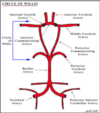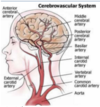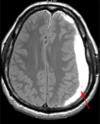Neuro Flashcards
dementia
what are 5 key features you may find?
1, memory loss
- speech and language difficulties
- problem solving difficulties
- impaired judgement
- may have mood issues
dementia
mood issues include? 5
depression
agitation
delusions
insomnia
disinhibition
what are 3 neurological features that might help explain the neuro changes seen in dementia?
- changes in cerebral circuits
- nerve loss
- changes in neurotrasmitters
what is the most common form of dementia?!
alzheimers
what are the 8 causes of the different types of dementia?
- alzheimers
- vascular dementia
- multi-infarct dementia
- frontotemporal dementias (huntingtons)
5 parkinsons dementia
- dementia with lewy bodies
- ETOH/drugs
- viral (creutzfeld-jakob)
what are the two most common forms of dementia?
1- parkinsons dementia-50%
alzheimers dementia
what to keep in mind about htis?
what causes this? 2
do they know they have it?
most common dementia
memmory loss can start as very subtle
progressive over years
NEURITIC PLAQUES (senile plaques)** and **amyloid deposition in arterial walls of neurons making neurofibillary tangles “neurons get all tangled up so they don’t work as well”
don’t recognize that they have it
behavior changes, may get lost
who is there a higher incidence of alzheimers dementia in?
down syndrome pts
alzheimers dementia
8 presentations
- word finding issues/speech difficulties
- wandering/getting lost
- poor judgement
- delusions
- agression
- sleep disturbance
- incontinence
- bedriddent status
alzheimers disease
why is it difficult to dx?
you can only confirm on autopsy with brain bx
what are the 3 most important risk factors for alzheimers dementia?
- OLD AGE—–most important RF
- family hx
- female gender
how do you confirm alzheimer on autopsy?
apolipoprotein 4 on autopsy
vascular dementias

what to remember about this?
who do you find this in?
what are the type?
SECOND MOST COMMON DEMENTIA
multi-infarct dementia in classically HTN pts
small or large infarcts known as lucunar** **and multiple cortical infarctions
**more sudden onset**
frontotemporal dementia
what is this caused by?
4 early sxs? what comes later?
what are 3 diseases that cause this?
caused by degeneration of the frontal (behavior) and temporal lobe
early features include:
- attention issues
- judgement impairment
- awareness
- behavior issues
***memory loss seen in later disease***
- huntingtons chorea
- picks disease
- progressive supranuclear palsy
huntington’s chorea
inheritance pattern?
where is defecT?
autosomal dominant-50% chance for kids
chromosome 4
frontotemporal dementia:
picks disease
what does this result in?
what do you see on testing?
tx?
anterior frontal and temporal cerebral cortex with MARKED personality changes
***intracellular inclusion (pick bodies) stain with silver stain
Tx:
NONE
tx behavior
what are the lewy bodies that are seen in dementia?

intaneuronal cytoplasmic includsions that stain with PAS staining
demenia:
progressive supranuclear palsy
what are 4 things this is qualifed by?
how long does the person have to live?
tx?
- falls
- gaze paralysis cant look down
- rigidity
- dementia
death within 5-10 years, no tx
dementia:
normal pressure hydrocephalus
what are 3 sxs?
2 dx methods?
1 tx?
- gate ataxia
- dementia
- urinary incontinence
**think falling adult who is incontinent**
DX:
- LARGE VENTIRICLES ON IMAGING/CT
- sume use MRI or CSF tap
tx: shunting
dementia:
korsakoff syndrome
what is this?
can’t recall recent memory despite immediate memory retention
easily confusable
what is a vitamin deficiency that can cause dementia?
B12…macrocytic anemia…causes spinal cord issues “myelepathy”
REPLACE IT
dementia
5 workup you want to do
- history
- mini mental exam
- full neuropsychiatric testing
- B12, thyroid function
- consider CT/MRI to turn our tumor/infarction
dementia
3 tx options for the actual dementia itself
- anti-acetylcholinesterase
**increase ach by inhibiting cholinesterase**
effects last about a year
- donepexil (aricept)
- galantamine
- riovastgmine
- NMDA receptor antagonists
**blocks this over-excitatory neurotransmitter**
used for mod to severe disease WITH ANTI-CHOLINESTERASE DRUGS
- Memantine (namenda)
- COMBO MEMANTINE PLUS DONEPEZIL for alzheimer dementia “Namzaric”
***all can be used in AD or parkinson’s dementia***
what are the goals of txing dementia with medication?
- delay progression of the disease
- improve caregiver disease
- decrease agitation
**can be used in AD and parkinsons…outcomes not as good in other dementia forms**
dementia
tx options for behavior
VERY DIFFICULT
antipsychotics:
- haloperidol
- resperidone
delirium
what is this?
how long can it last?
what are 3 things it can be attributed to?
acute confusional state with decreased attention
hours to days, even months-years
1. usually due to cerebral dysfunction
2. can be abnormal acetylcholine levels
3. high dopamine
**can minic dementia**
what are 4 things that can cause delirium?
- older age
- baseline dysfunction
failing health, dementia, nursing home pts
- poor sleep
- hospitalizations
catheters, restraints, sleep deprevation, multiple meds, pain
delerium:
ICU psychosis
what is this?
4 causes?
r/o?
illness
(sepsis, fever, dehydration, drug abuse)
must rule out stroke
delerium:
sundowning
what is this?
2 tx options?
old people get worse at night
tx:
- maintain day-awake, night sleep
- reassurance/reorientation
delerium:
alcohol withdrawal/delirium tremens
what are these and when are they the worst?
4 sxs?
5 tx options?
delirium temors stem from acute alcohol withdrawal and peak 2-3 days after cessation
SXS:
- agitation/axiety
- tremor
- hallucinations
- ANS instability (increased BP, pulse, resp)
TX:
- B vitamins
2. hydration
3. benzodiazepines
a. diazepam
b. chlordiazepoxide
IV or PO
c. high dose benzos for bad DTs
4. phenobarbitol
5. antipsychotics
a.haloperidol
delerium:
5 presentations and whicho ne is most important?
- decreased attention
- change in sleep/wake cycles
- hallucinations
- delusions
- hypo/hyperactive status
delerium
what are 3 dx options?
what are 5 tx options?
dx:
- clinical at bedside
- compare baseline function (ask family)
- check for meidcations causes (anticholinergics, sedatives, narcotics, benzos)
Tx:
- supportive/reorientation
- day-night normalcy
- bed alarms, sitters
- antipsychotics- haloperidol
- benzodiazepine-diazepam
VERY DIFFICULT
seizure
what are the two maine categories of this?
what causes each?
1
3
partial:
a. deranged area of the cerebral cortex often due to STRUCTURAL ABRNOMALITY CONCIOUSNESS IS PRESERVED
**keep in mind in the subcategory of this complex partial conciousnesses is IMPARIED=PARADOX..it just doesn’t make sense**
generalized:
a. diffuse region of the brain firing
b. often widespread problem:
- cellular disorder aka mental retardation
- biochemical disruption: low Na
- structual: brain tumor
PARTIAL:
SIMPLE PARTIAL SEIZURE
9 sxs of this
2 dx
sxs:
- no loss of conciousness
- isolated** **tonic/clonic with repetitive flexion and extension
- hand tremor on opposit side of issue
- jacksonian march
motor activity begins distally like fingers and spread through entire extremity, can lead to entire side of body
- todds paralysis
local parethesia lasting minutes to hours
6.changes in somatic sensations (parersthesias)
7. changes in vision (flashing lights, hallucinations)
8. changes in equilibrium (falling, vertigo)
9. autonomic changes (flushing/sweating)
DX:
EEG spike waves in FOCAL area of the brain or during jacksonian march
PARTIAL:
COMPLEX PARTIAL SEIZURE
what are 3 sxs with this? 3 examples
SXS:
- impaired conciousness, loss of contact with environment “ictal stage”
a. STARING-kinda asleep and staring off into space, can’t wake them
b. AMNESIA-forgetting/impaired memory
c. involuntary picking/chewing
- preceeding aura
- post ictal confusion
Lasts seconds to hurs, EEG notmal between spells
PARTIAL:
partial with secondary generalization
when does this occur?
what type of seizure does this produce?
electrical discharge spread and both hemispheres become involved
TONIC CLONIC SEIZURE
common when partial seizures occur in the frontal lobe
GENERALIZED:
absence seizures-petit mal
who does this occur in?
when do they stop?
3 sxs with 5 subtle findings?
1 DX with 3 findings?
childhood 4-8 years, 15-20% of childhood seizures, MOST RESOLVE IN CHILDHOOD
NO CONVULSIONS
- LOSS OF CONCIOUSNESS
- few seconds
- subtle findings
eye blinking
FACIAL TWITCHING
chewing
clonic movement of hands
all day long daydreaming appearance
DX:
- EEG
- general symmetrical discharge
- spike and wave
- WORSEN WITH HYPERVENTILATION MANEUVER
GENERALIZED:
atypical absence seizures
what differentiates these from absence seixures?
who might they occur in? 2
same as absence but LAST LONGER with more motor features
may have brain abnormlaity like mental retardation or developmental delay
HARDER TO TX
GENERALIZED: generalized tonic/clonic seziures “Grand mal”
What is this most commone cause of this?
How fast do they occur?
6 sxs seen?
10% will have epilepsy
caused by metabolic derrangement
SUDDEN ONSET
SXS:
- convulsive
- increased muscle tone stiff
- moan or cry
- change in respiration (secretions, cyanosis, jaw clench)
- clonic activity: muscle relax and contract
- post ictal state:
unresponsive,
flaccid,
salivation/airway obstruction, bowel/bladder incontinence
GENERALIZED:
tonic-clonic Grand mal seizures
what do you find on the EEG between the two phases?
dX EEG:
tonic phase:
increased low voltage fast activity
high amplitude polyspike discharge
clonic phase:
spike and wave activity develops
GENERALIZED:
tonic-clonic Grand mal seizures variation
myoclonic seizure
what is this?
who do you see this in?
brief contraction or jerk like when you fall asleep and twitch
*seen in brain injuries*
Generalized:
juvenille myoclonic seizure
who is this in? does it go away?
1 sxs?
when is it worse? 2
adolescence, spontaneous remission
billateral jerk with maintained conciousness
worse with awakening and sleep deprevation
GENERALIZED:
lennox gastaut syndrome
who is this in?
what are 4 things it is associated with?
children!!
impaired cognitive function
associated with CNS:
developmental delay
trauma
infection
neural injuries
GENERALIZED:
mesial temporal lobe epilepsy
what is the dx for this?
MRI shows hippocampal sclerosis
explain the patho of seizures?
6 steps
- burst of electrical activity
- influx of calcium, aided by NMDA
- influx of sodium, aided by GABA or K channels
- spikes discharge
- inhibitory neurons overloaded with calcium and k
- propogation of action potentials
what can seizures come from?
1 theory?
5 causes?
harrisons: shift in balance of excitation and inhibition of the CNS
- change in seizure threshold
- genetic role
- traumatic brain injury
- strokes infection
- stress, sleep deprevation, menses, medications
febrile seizures
who does this occur in?
3 associations?
how many?
3 months-5 years
infection related:
ottitis media
respiratory
gastro
can be complex (multiple) or simple (single)
what causes 50% of new seizures in adults?
cerebrovascular disease
how do you dx a seixure?
4 (+findings)
- hx is key, from bystander or witness
- EEG: starts or stops abruptly activity during tonic-clonic inter-ictal-spikes or sharp waves
- sometimes MRI
- blood test, elevated prolactin in the first 30 mins
seizure tx
3 tx options?
specific medicaitons? 6
- MEDICATION MANAGEMENT
- CARBAMAZEPINE
-PHENYTOIN
-lamotrigine
-valproic acid
-gabapentin (partial)
-pregabalin (partial)
- SURGICAL
- temporal lobectomy
- focal lesion removal - VAGAL NERVE STIMULATOR
- put electrode in vagus nerve, increases the seizure threshold

status epilepticus
what is this and how long does it last?
is this serious? why? 3
5 causes of this?
continuous seiziure
15-30 mins
MEDICAL EMERGENCY
- cardiovascualr implicaitons
- hyperthermia
- CNS injury
causes:
metabolic problems
drugs
CNS infection
head injury
refractory epilepsy
status epilepticus
4 tx options?
dx: metabolic workup
Tx:
- benzodiazepine ( lorazepam, diazepam, midazolam)
2. phenytoin
3. phenobarbital
4. anesthesia
multiple sclerosis
what is this caused by?
when does it start?
who is it more common in?
what are the 5 types?
autoimmune that causes inflammation and demyleination of the CMS which makes the neurons not able to function
onset usually 20s to 30s
more common in women, more severe in men
types:
- CIS
- RRMS
- Primary progressive
- secondary progressives (SPMS)
- progressive relapsing
what are 5 RF for multiple sclerosis?
- northern europe
- southern canada
- northern US
- western europe in temporate zones
- family hx

multiple sclerosis:
relapsing remitting MS
ehsy is the pattern of this?
5 things it can lead to over time?
6 sxs?
an initial episode then months or years later sxs emerge or previous sxs return for more than 24 hours
cycle of incomplete reission and progressive disability
- weakness
- spasticity
- ataxia in limbs
- impaired vision
- urinary incontinence
despite remission steady decline still dominates the disease course
sxs:
optic atrophy
nystagmus
dysarthria
cerebellar deficits
uhthoffs pnehomenon-SXS GET WORSE IN HOT ENVIRONMENT!!!
internuclear opthalmaplegia-eye move independent
think sensory issues in teh limb followed by vision change

multiple sclerosis:
secondary progressive (SPMS)
what is this?
most patients will progress to this
initial relapsing-remitting that sudddenly begins to have decliend without periods of remisssion (gets more disabiltiy)

multiple sclerosis:
progressive relapsing
what is the pattern of this?
steady decline since onset with superimposed attacks

multiple sclerosis:
10 sxs of this
- numbess/weakness
- numbness and tingling
- unsteadiness in th limb
- spastic paralysis
- retro neuritis/ optic neuririrs
-sudden color loss
-impaired night vision
-pain with eye movemtn
-blurred or dimmed vition
6. vertigo
7.urinar incontinence from loss of spincter control
8. interneuclear opthalmaplegia (eyes move independently)
9. uhthoff pnenomenon-gets worse in the heat
10. l’hermettes syndrome: shock like feeling throughout body

multiple sclerosis:

3 dx methods/criteria?
what do you find on each?
- mcdonald criteria:

2 or more different** areas in central white matter in the brain that are **affected at differnt times
***aka you get two lesions on imaging at different times**
- MRI IS TOC FOR THIS!!:
SEE PLAQUE THAT IS REGION OF DEMYLEINATION WITH PRESEVED AXON
**FIND LESIONS IN: PERIVENTRICULAR, JUXTACORTICAL, INFRATENTORIAL, OR SPINAL CORD**
- LUMBAR PUNCTURE
a. oligoclonal bands highly suggestive of MS
b. lymphocytosis
c. albumin (disruption of BBB)






























